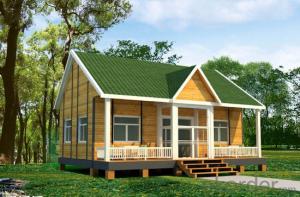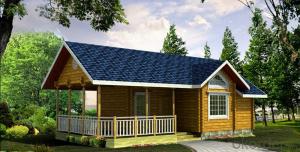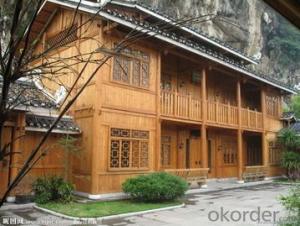New Designed wooden house
- Loading Port:
- China Main Port
- Payment Terms:
- TT OR LC
- Min Order Qty:
- -
- Supply Capability:
- -
OKorder Service Pledge
OKorder Financial Service
You Might Also Like
wooden villa house
Simple and founctional family living house
Specifications
1,Easy installation;
2,Easy disassemble;
3.Service life: 20 years or more;
4.Competitive price;
5.Environmental products;
Can be made according to customers' design or plans
No pollution during the construction because of using no-toxic green material
High degree of stiffness and light weight
Concrete foundation
Earthquake and wind resistance
Natural living environment can bring happy and healthy life to you!
if you are interested in this model, please feel free to contact me, more details will be sent to you.
- Q: Can container houses be designed with a spacious interior?
- Yes, container houses can be designed with a spacious interior. Although containers have a limited width, typically 8 feet, they can be combined horizontally or vertically to create larger living spaces. By removing interior walls, using open floor plans, and incorporating clever storage solutions, container houses can feel more spacious. Additionally, large windows and skylights can be added to bring in natural light and make the interior feel more open and airy. With thoughtful design and maximizing the available space, container houses can provide a comfortable and spacious living environment.
- Q: Are container houses eligible for financing?
- Container houses are indeed able to receive financing. Similar to conventional houses, container houses can be financed through different methods. These methods include securing a mortgage loan from a bank or financial institution, applying for a personal loan, or exploring financing alternatives designed specifically for container homes. It is crucial to bear in mind that eligibility may differ depending on the lender's criteria, the container house's location, and other factors. It is recommended that thorough research is conducted and financial institutions or specialized lenders with expertise in financing container homes are consulted to ascertain the particular requirements and available options.
- Q: Can container houses be designed with a vintage or retro-inspired look?
- Yes, container houses can definitely be designed with a vintage or retro-inspired look. By incorporating elements such as reclaimed wood, vintage furniture, retro appliances, and nostalgic decor, container houses can be transformed into charming spaces that evoke a sense of nostalgia and classic design. With a mix of creativity and thoughtful planning, container houses can achieve a vintage or retro-inspired aesthetic while still maintaining their unique and sustainable nature.
- Q: Can container houses be designed with a minimalist or Scandinavian style?
- Yes, container houses can definitely be designed with a minimalist or Scandinavian style. The modular nature of containers allows for creative customization, making it possible to incorporate clean lines, neutral colors, and functional yet aesthetically pleasing elements commonly associated with minimalism or Scandinavian design. By utilizing clever storage solutions and sleek furnishings, a container house can reflect the simplicity and elegance characteristic of these styles.
- Q: Can container houses be built off-grid?
- Indeed, it is possible to construct container houses that operate independently from public utilities, a concept known as off-grid living. Container houses can be customized and engineered to adhere to the criteria of off-grid living. To achieve an off-grid container house, a range of systems can be implemented. Installation of solar panels on the roof enables the generation of electricity, which can then be stored in batteries for use during cloudy days or at night. Additionally, a rainwater harvesting system can be established to collect and store rainwater for daily use, thereby reducing reliance on municipal water supplies. These container houses can also integrate composting toilets or septic tanks to manage waste, eliminating the need for a connection to a sewage system. Greywater recycling systems can be employed to treat and recycle wastewater from sinks, showers, and washing machines, effectively minimizing water consumption. Moreover, optimization of insulation and ventilation is crucial for maintaining a regulated interior temperature, thereby reducing the necessity for heating or cooling systems. This can be achieved through the utilization of energy-efficient windows, insulation materials, and natural ventilation techniques. Container houses possess adaptability and can be constructed in remote locations, making them ideally suited for off-grid living. With appropriate modifications and the implementation of requisite systems, container houses can offer a sustainable and self-sufficient living solution.
- Q: Can container houses be designed with a communal garden?
- Yes, container houses can certainly be designed with a communal garden. With proper planning and design, communal garden spaces can be incorporated into the layout of container houses, allowing residents to enjoy the benefits of gardening and fostering a sense of community.
- Q: What are the ancillary facilities in the office?
- A professional office space is basically to support these facilities: business district, large and small conference rooms
- Q: Can container houses be built with a traditional bedroom layout?
- Yes, container houses can be built with a traditional bedroom layout. The modular nature of container homes allows for customization and flexibility in design, including the incorporation of traditional bedroom layouts. By combining multiple containers or modifying their interior structure, container houses can accommodate bedrooms with standard features such as walls, doors, windows, and adequate space for furniture placement.
- Q: Are container houses suitable for areas with extreme weather conditions?
- Container houses can be suitable for areas with extreme weather conditions, but it largely depends on how they are designed and constructed. With proper insulation and reinforcement, container houses can withstand extreme heat, cold, wind, and even seismic activity. One key advantage of container houses is their structural strength. Shipping containers are built to withstand harsh conditions during transportation, including storms and rough seas. This inherent strength makes them a good choice for areas prone to hurricanes, tornadoes, or heavy snow loads. By reinforcing the container with additional steel supports, it can further enhance its ability to withstand extreme weather conditions. Insulation is another crucial factor in making container houses suitable for extreme weather. Proper insulation helps regulate the internal temperature, keeping the interior cool in hot climates and warm in cold climates. This can be achieved through various insulation materials, such as spray foam, rigid foam boards, or fiberglass batts. Additionally, double-glazed windows and energy-efficient doors can contribute to better insulation and energy savings. Furthermore, container houses can be designed with features that mitigate the impact of extreme weather. For example, sloped roofs can help shed snow or rainwater more effectively, preventing excessive weight or leakage. Installing hurricane shutters or impact-resistant windows can protect against high winds and flying debris. Additionally, incorporating passive design principles, like strategic placement of windows for natural light and ventilation, can help reduce reliance on mechanical heating or cooling systems. However, it is important to note that container houses still require proper planning, engineering, and professional construction to ensure their suitability for extreme weather conditions. Local building codes and regulations should be followed, and consultation with experts in container house construction is highly recommended. With the right design, materials, and construction techniques, container houses can indeed be a viable option for areas with extreme weather conditions.
- Q: Can container houses be designed to have a traditional aesthetic?
- Yes, container houses can be designed to have a traditional aesthetic. With the right architectural planning and design elements, container houses can incorporate traditional features such as pitched roofs, ornamental details, and traditional finishes. The exterior façade can be modified to resemble traditional materials like wood or brick, allowing container houses to blend seamlessly with the surrounding traditional architecture. Additionally, the interior can be designed to include traditional elements like crown molding, wainscoting, and traditional-style furnishings, further enhancing the traditional aesthetic.
Send your message to us
New Designed wooden house
- Loading Port:
- China Main Port
- Payment Terms:
- TT OR LC
- Min Order Qty:
- -
- Supply Capability:
- -
OKorder Service Pledge
OKorder Financial Service
Similar products
Hot products
Hot Searches
























